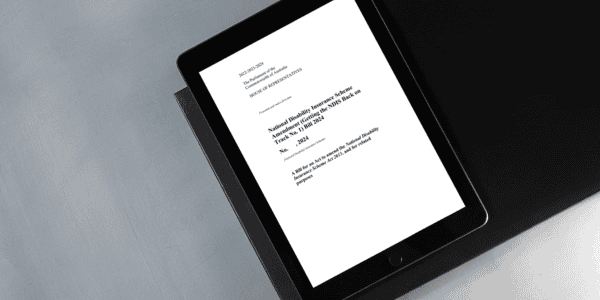
Originally announced in March, the much anticipated National Disability Insurance Scheme Amendment (Getting the NDIS Back on Track No. 1) Bill 2024 finally passed Parliament on 22 August 2024. But what does this actually mean for people with disability and those receiving NDIS supports?
What’s happened?
The National Disability Insurance Scheme Amendment (Getting the NDIS Back on Track No. 1) Bill 2024 (the Bill) was passed by parliament on 22 August 2024. The legislation will become Law 29 days after Royal Ascent and, according to the National Disability Insurance Agency (NDIA), is expected to be rolled out from mid-to-late September.
Where did the Bill come from?
The Bill is the first reform to come from the NDIS Review and introduces the legislative tools and instruments required to implement some of the recommendations made in the NDIS Review.
The NDIS Review itself took place over 12 months, with the recommendations published in December 2023. The government has yet to release a full response to the recommendations, but the government introduced the Bill in March 2024, leaving many people – especially those with disability – feeling the Bill was rushed and lacked consultation.
What will change following the passing of the Bill?
Importantly, nothing will change until mid-to-late September 2024. Until changes are made, the NDIA has said that
- all access and planning processes, decisions and supports will continue in line with current operational guidance.
- participants should continue spending in accordance with their plans and existing operational guidance.
- providers should continue to claim for supports in line with current operational guidance.
When changes are introduced, they will be introduced in a staged approach. The timeframe for the changes introduced by the Bill is five years. Some changes will happen quickly, and others will happen over a five-year period, with significant co-design and consultation to get to the final vision of the Bill.
Many of the NDIS Rules that sit beneath the NDIS Act are yet to be defined. The NDIA will work with the community to co-design the Rules that define how people can access the NDIS, what assessments are needed and how budgets will work.
What will change first?
A number of areas have been prioritised for early action and will come into effect as soon as the law is passed. These are:
Section 10 – Definition of NDIS supports
The new Bill enables the creation of a new rule that outlines what is and isn’t an NDIS support – what can and can’t be funded by the NDIS. Consultation on a draft list closed on August 25, with feedback to be taken into consideration before a final list is legislated. It is expected that a transitional NDIS Supports rule will be in place as soon as the legislation is passed and will have effect until the new NDIS Supports rule is agreed.
Section 19 – Limit on making new access request
If you have your status as a participant revoked and request a review of that decision, you cannot make another access request until your review is complete.
Section 24 – Disability requirements
Disability requirements have been updated to clarify that a person should only access the NDIS if they require supports which are NDIS supports.
This makes it clearer when a mainstream system is responsible for providing support.
Section 25 – Early intervention requirements
Early intervention requirements have been updated to clarify that a person should only access the NDIS if they require supports which are NDIS supports.
This makes it clearer when a mainstream system is responsible for providing early intervention support.
Section 30 – Information gathering for deciding whether to revoke participant’s status
The NDIA can now request specific information or ask you to do something like have an assessment in order to review your status as a participant.
The NDIA also now has the power to revoke access to the NDIS if you do not respond to their request for information.
Section 33 – Total funding amounts, funding component amounts and funding periods
Plans approved after the law comes into effect will show total funding amounts, funding component amounts and funding periods.
This clarifies the amount of funds available in the plan and how long the funds need to last and is designed to ensure funding is not exhausted ahead of time.
Section 34 – Supports for impairments
Under amendments to Section 34, the NDIA will only fund NDIS supports related to the impairment(s) you meet access for.
Section 44 – Plan management decision
The NDIA is now able to change your plan management type in certain circumstances, including if the NDIA think:
- you
- your nominee
- your plan manager
- a child representative
Are unlikely to spend your NDIS funds properly relating to:
- NDIS supports and
- in line with your plan
Section 45A – Claims and payments framework
The new Bill has introduced a legislative claims and payments framework that will provide clarity on how claims should be made.
Section 47A – Plan variations
If participants have a new plan created after the law comes into effect – a plan with total funding amounts, funding components and funding periods – the Act ensures funding amounts and periods can be varied in some circumstances.
What are some of the longer-term changes?
The Act changes how someone qualifies for funding.
There are currently two ways to receive NDIS funding – also known as Tier 3 supports
- Adults have to prove they have a permanent and significant disability and need support with daily living. The person requires a diagnosis that is eligible for NDIS funding. They then meet a planner, are assigned a budget based on goals, and receive itemised funding, which constitutes a plan. Each line item on the plan needs to be measured against the NDIA’s criteria of ‘reasonable and necessary.’ Under this approach, people with similar diagnoses often receive variable budgets depending on how well they advocate for their supports.
- Children under the age of 9 do not need a specific diagnosis. If they’re not meeting accepted milestones of early childhood, they work with a childhood partner to access supports. Children do not receive personalised plans in the same way an adult does but are still able to access supports.
Following legislation of the Bill, people with disability will be assessed in order to access the NDIS and to receive an appropriate plan budget. This is a long-term plan.
In five years, the vision of the Bill is that an assessment process will assess need and a tool will calculate budget based on need. Neither the assessment nor the tool are yet designed, and the government has committed to co-designing these elements with people with lived experience.
Summary of key changes
- Introduction of lists outlining what NDIS funding can and can’t be spent on – this is an immediate change and will exclude some supports / services. The list is not yet final and Participants will be able to argue for funding for an item contained on the ‘No’ list.
- The Government will be required to be transparent when making changes to NDIS rules. They will have to publish information, consult with the community and ensure the majority of States agree to the changes.
- A legislated claims process has been introduced, giving the NDIA powers to formalise a claims process. Claims for expenses from more than two years ago will not be able to be made.
- Introduction of total plan amount and mechanisms for restricting spending – if debt is incurred accidentally, it can be waived, but debts will be incurred by individuals if they overspend.
- Introduction of an assessment tool to calculate plan based on whole of person need – The NDIS will be able to use a tool to decide a total funding package. The tool has to be designed with the community.
- Providing notice of impairments – rather than recording primary and secondary disability for each Participant, Participants will receive a list of NDIS-recognised impairments that their funding is based on. This required the NDIA to outline the impairments and will likely pave the way for the assessment process.
- Written requests by the NDIA – The NDIA has new powers to request documentation and to act if not responded to. This may involve the suspension of plans.
- Inclusion of Indigenous Board Member – the Agency will be required to have an Indigenous member on its Board.
- Monthly updates – the Agency will have to publish monthly (rather than quarterly) statistics on spending and Participant numbers.
Civic is committed to supporting clients and our wider community to understand what is changing and how it impacts them. You can find more information on the changes below, and if you have any questions regarding the Bill and whether it impacts the services you receive, please contact enquiries@civic.org.au.
More information
The NDIA has published a summary of the changes, which can be viewed here. https://www.ndis.gov.au/news/10305-changes-ndis-legislation
NDIA CEO Statement https://www.ndis.gov.au/news/10303-ceo-statement-getting-ndis-back-track-bill
Please note the above information was current as of 4 September 2024


